Nikon D7000, an eclectic's user report
Page 3 of 3. Version 1.3, ©2011 by Dale Cotton, all rights reserved.
Image Quality 1: Resolution
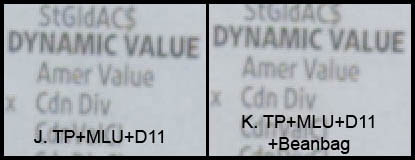
J and K segments from Fig. 7
OK: I've got this nifty 16.2 megapixel sensor, so how does it perform? I'm not in a position to give you an actual number, but DPReview staff are and that number is 2650 line pairs per picture height, which is disturbingly close to the 2700 to 2800 that full frame monsters like the Canon 5D II and the Sony A900 and the Nikon D3X weigh in at. What we can see from Fig. 7 J and K is that even the kit 18-105 when shot on a tripod at F/8 and at base ISO can get us right down to the minimum softness introduced by the anti-aliasing filter. That tells me that no resolution is being swallowed up within the guts of the camera. And that means that, yes, you can get your 16.2 megapixels' worth of detail out of the camera if you're willing to put in the effort to do so.
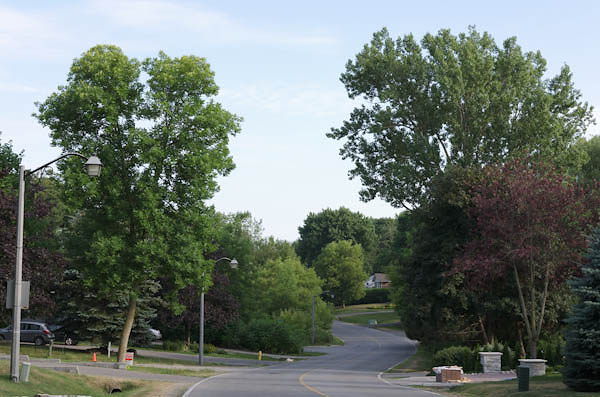
Fig. 8: typical handheld shot from D7000. (F/8, 1/90th, 45mm)
Fig. 8 is a typical handheld shot from the camera (VR, Q shutter, D11). The little JPEG shown above won't tell you much, so click here for the original raw file (22 MB), and here for a full-size JPEG (4 MB) developed from that raw file with only a minimal amount of sharpening added.
Upgrading just for resolution: On the other hand, as illustrated in the previous section, you need to jump through several hoops to keep from losing half those megapixels to vibration blur. Plus, you need a good enough lens set to a small enough aperture. So the step up in resolution from the more common 12 MP sensor is not something most of us are likely to see all that often.
Image Quality 2: Dynamic Range and High ISO Noise
The following test shots were taken in raw, developed in Lightroom with fill light at max and chroma noise reduction at max, then opened in Photoshop where I applied a very strong curve to open the shadows. I spot-metered to place the brightest part of the scene just shy of over-exposure. If you've ever taken a window shot like this that preserves highlights you know that everything surrounding the window is either ink-black or nearly ink-black, hence the huge boost to the shadow areas in post processing. It's not that we would do this in "real life"; it's just a ploy to let us see clearly the relative noise levels in the deepest shadows, and hence make a call at DR and noise levels. I've marked exposure values (EVs) at various points:
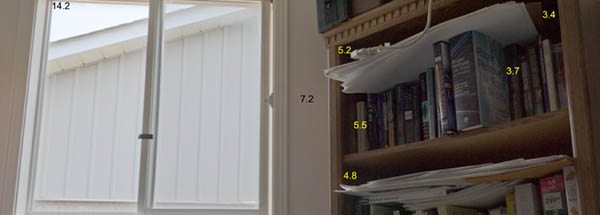
Fig. 9: DR test shot, 100 ISO
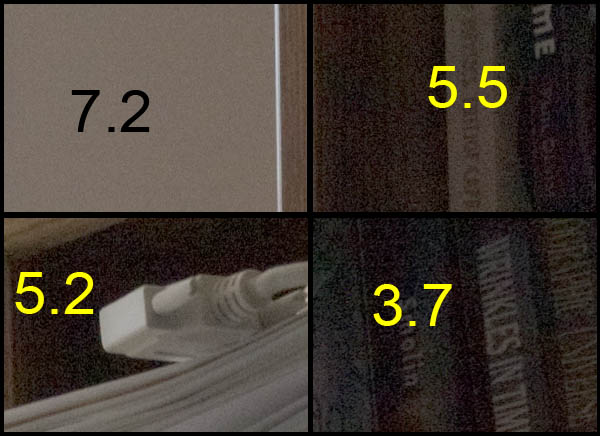
Fig. 10. 100 ISO crops
Click here to download original raw file used for Figs. 9 and 10 (17 MB).
As you can see from the Figs. 7 and 8, there is enough noise to cause mild granularity at EV 7.2 (DR = 7 stops). Colour bleeding starts at DR = 8 or so. But some degree of detail is still discernible down to an incredible DR = 10.5. The upshot is that if you work at base ISO and expose carefully the D7000 will repay you with the same sort of latitude as a really good print film.
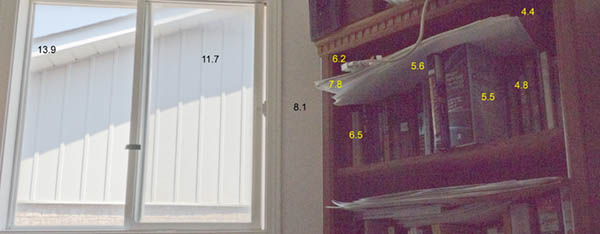
Fig. 11: 1600 ISO
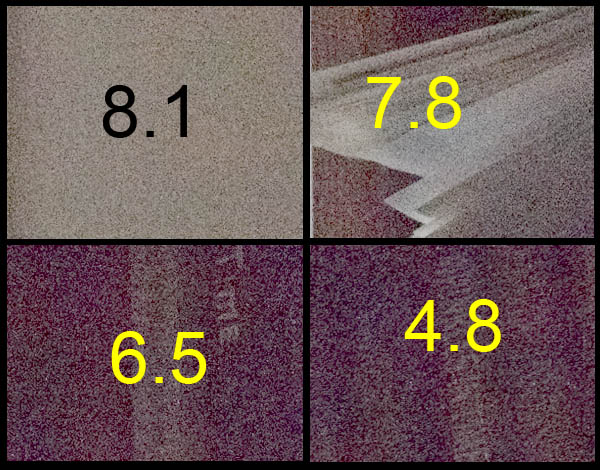
Fig 12. 1600 crops
Click here to download original raw file used for Figs. 11 and 12 (18.5 MB).
At 1600 ISO, of course, things are a wee different. Colour bleeding has set in at DR = 5 stops, and noise has pretty much obliterated all shadow detail by DR = 9. I'm going to call the DR for 1600 ISO as 7.5 stops, but you're free to argue. ;)

Fig. 13: pattern noise at 6400 ISO
Even more important to me is the great improvement in pattern noise over the hideous banding I was getting from my Pentax. Figure 11 (lens cap shot at 6400 ISO then pushed 4 stops in Lightroom) shows that even at 6400 ISO pattern noise is only moderate and something you're not likely to see in the vast majority of even your high ISO images:
Under-expose instead of high ISO?: in a fascinating article called Pentax K-5: the Perfect Sensor? Guillermo Luijk examines the possibility of simply under-exposing a shot in low light rather than changing to a higher ISO, then upping the exposure in raw development. In practice, if the shot requires 1/60th second at f/4 at 800 ISO, Guillermo asks what happens if we take the same shot at 1/60th second at f/4 at 100 ISO using a Pentax K-5. The answer is that the noise levels in the two shots are about the same, but the 100 ISO shot retains the full 10+ stops of dynamic range.
The Nikon D7000 uses the same 16 MP Sony sensor as the Pentax K-5; my tests show a bit more noise at 100 ISO than at high ISOs, but the difference is pretty small. The main problem is that you have a really dark shot in the camera, so chimping with the LCD monitor doesn't tell you whether or not you nailed it. That said, there is no law says you can't shoot at, say, 400 ISO and under-expose two stops instead of shooting at 1600 ISO. This would give you two stops' benefit of DR while having a less inky image to chimp.
Image Quality 3: Colour Depth and Accuracy
Last but not least, colour depth. Because our monitors are typically 8-bit sRGB devices and the dithering pattern of even the best inkjet printers hardly exceeds 8 bits per channel of subtlety, whether or cameras are 12-bit or 14-bit colour devices is something more obvious on a spec sheet than in daily experience. Where it does come visibly into play is when we start tossing away bit depth by upping the ISO level (and the above under-exposure trip is no help here). Just as the D7000 gives me two stops more DR at any given ISO than my previous dSLR, so it also gives me a stop better colour response at each ISO. This, after all, is implicit in the DR and ISO numbers. You get better DR, at least in part, when you have a better signal-to-noise ratio (SNR), The less noise you have at a given signal boost (ISO increment) the higher you can go in ISO settings before you may as well not bother. And the fewer pixels that are wiped out by noise at any given ISO setting, the more pixels that are actually doing their job of reporting scene colour.
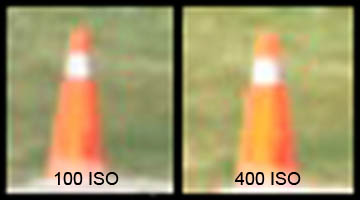
Fig. 14: posterization at higher ISOs (small crop, 4x mag)
Just as we lose DR for each stop we increase ISO, so also we have fewer bits of real colour information per pixel for each stop we increase ISO. Even shooting at 400 ISO we can lose enough bits of colour information to cause a visible cartoonish colour degradation technically called posterization, as we can see in Fig. 14.
Less obviously, we think of base ISO as being a totally clean signal, but that's far from the case. There is noise in any base ISO image even in the brightest areas; the darker you go into the shadows the fewer the photons being collected and the more obvious the system noise becomes. So there are real differences between cameras even at base ISO: it's just that it's so easy for software noise reduction to handle the noise that's there that we don't realize there ever was any noise to begin with. We may never see it, but it does affect the colour depth and therefore the colour gradation capability of a camera's output at base ISO. And again, any improvement of the D7000 over the last generation shows up at base ISO as well as in lower light.
Another colour consideration is accuracy. I use the latest Lightroom to develop my raws, and I'm blown away by the default camera profile for the D7000. I did my own (single luminant) profile in the same light and can't see any difference by swapping between the two. I shoot raw instead of JPEG, but comparing the D7000's side-car JPEGs with Lightroom conversion in linear, all I had to do was drop the JPEG contrast parameter to minimum and leave saturation at the default to get very much that same highly realistic colour handling. Very nice.
Wrap-up 1: comparisons
In the opener I argued that a really good APS-C dSLR with one really good lens makes a compelling multi-purpose tool that's light enough to carry around all day but can produce images that meet pretty high standards on all counts. So the questions are whether the D7000 is a really good APS-C dSLR and whether the 18-105 kit lens is a really good lens. I've tried to supply enough objective information (except regarding AF and flash) that you can make your own call on both counts. For my part, my 15-day no-ask return window has come and gone (although I had a bit of panic on day 13 ;), and I still have the camera.
Still: even if you agree with me that the D7000 is a sweet piece of kit, if the premise is one body + lens combo to meet your carry-everywhere needs, why would you not instead opt for a smaller alternative like the Panasonic G3 or the Sony NEX-C3? After all, these are each 16 megapixel devices with raw output.
| Camera | Body wt | Lens* wt | Total | Finder | Controls | DxO DR | DxO ISO | DxO Clr |
|---|---|---|---|---|---|---|---|---|
| D700 | 780gm | 420gm | 1200gm | 100% opt. | All | 13.9 | 1167 | 23.5 |
| GH2 | 442gm | 640gm | 1002gm | EVF | All | 11.3 | 665 | 21.2 |
| NEX-C3 | 225gm | 194gm | 419gm | LCD | Few | 12.2 | 1083 | 22.7 |
* Lens weight is for the kit zoom in each case.
It all depends on what compromises you're willing to make to bring your carry weight and size down. The GH2 is mirrorless, but the actual difference in weight is only 200 grams. Plus, you lose the superb 100% prism finder and take a big hit in both DR and low light capability. These could be acceptable trade-offs depending on your needs – but for a gain of only 200 grams? I'd rather go for the D5100 in that case. OK: the NEX is certainly lighter at 1/3 the weight. It contains the same sensor, so IQ should be the same, right? Not quite, sayeth DxO. More importantly, the NEX has no EVF option, and it's control set is so crippled you can't even do an exposure lock then re-compose.
You can explore the differences between these cameras with this feature side-by-side on DPReview and with this IQ side-by-side on DxOMark. (The DxOMark dynamic range numbers for the D7000 differ from mine in the Dynamic Range section above mainly because they're reporting the number of stops to total signal loss – 13.9, while I'm reporting my personal take on how many of those stops are actually usable – 10.5.)
If that's what we've gained by opting for a good APS-C kit, what have we lost by not opting for full frame? Well, for one thing, quite a bit of weight. It we take the Canon 5D II as the lightest FF dSLR currently available, that's still 1230 grams for the body. Plus: just one appropriately high quality lens, such as the 24-70 f/2.8 weighs in at 950 grams, for a total of 2180 grams or 4.8 pounds. And of course the price is similarly hefty.
Sony NEX-7: Just announce as I write this, I can imagine people wondering why buy a 16 MP dSLR when one can now buy something smaller, lighter, and sexier but with even greater resolution? The first thing to consider is that you're not going to get anything like 24 MP of detail from this camera without putting it on a really good tripod. And if you have a full tripod without, what point the miniature camera size? The NEX-7's EVF sounds remarkable and finally we have a NEX model that offers full user controls. So my initial take is: ignore the 24 MP number but consider carefully if small, light, and unobtrusive are your watchwords.
But in terms of image quality, again DPReview reports 2750 line pairs for the 5D II's 21 MP sensor (and similar numbers for the D3X and A900) while the D7000's mere 16 MP sensor shows 2650 line pairs, only a 4% improvement for FF. For DR, high ISO, and colour DxOMark shows the 5D II as having a DR of 11.9 (down 2 stops), an ISO of 1815 (up 1/4 stop), and bit depth of 23.7 (same). You'd have to go to the even heavier and much pricier Nikon D3X to regain the DR you actually lost by moving up to the 5D II, and you still don't get a dramatic gain in measured resolution. Our APS-C prejudices and expectations aside, the D7000 is punching 'way above its weight in image quality and hangs right in there with the vaunted full frame crowd.
Wrap-up 2: evaluation
I mentioned at the top that Nikon classifies the D7000, like the D700, as a pro body (and counts D7000 ownership toward the pre-requisites for buying into their pro-support policy). The 100% frame prism finder certainly argues on the D7000's behalf; as does its complete control set. And, surprisingly so does its objective image quality, in spite it sporting a DX sensor. It accepts pro-grade lenses, albeit with a 1.5 mag crop factor. Auto-focus seems top-notch. A battery pack/grip option exists. Frame rate is a not-too-bad 6 FPS. As a camera body, Nikon rates it as "weather resistant", whatever that means. The chief down-check is that the body has only a partial metal shell, but even then Nikon clearly thinks it's rugged enough for pro use.
From one perspective it seems too small and fragile for a pro to take seriously. From another perspective it looks too large and heavy to compete with the new mirrorless crowd. But one could also make a compelling argument that it punches 'way above its weight in every regard except sheer ruggedness. My own perspective is somewhere in the middle. This is the first camera I've owned since shooting film about which I feel absolutely no disappointment in any aspect of image quality. So far as I'm concerned sensor and image pipeline development could stop right here. The only items now on my wish-list are:
- A new metering pattern that automatically prevents blown highlights
- Better mirror vibration damping
- Even quieter shutter/mirror sound output
- Over-all miniaturization.
As I've already mentioned, the D7000 is about the same weight as Nikon's small film bodies from days gone by. So, by miniaturization I mean not so much lowering the weight, but making both the camera (and if possible the lenses) physically smaller. I fully understand that too small a camera body would be inappropriate with a 400mm/f4 lens stuck on the front. But for many types of photography (street, candids, photojournalism, hiking) large, long lenses are rarely used and the smaller and less obtrusive the camera body, the more at ease human subjects will be having the camera pointed their way. So any further size (not weight) reduction would be welcome by many.
The above are not criticisms, just suggested improvements. If I have one real criticism of the camera not yet mentioned, it's a peculiar one. Watching forum traffic regarding the D7000 for a few months now, what I'm consistently seeing are beginners and casual amateurs in over their heads. Nikon classes the camera as pro in some serious ways, but contradicts that by including scene mode, full auto mode, and similar hand-holding options on the interface. This seems to be sending a confusing message to potential buyers. It suggests that if you care to spend a few more C notes you can buy the D7000 and get even better image quality ... without needing any particular expertise in using it. Instead, we see users totally lost in a sea of interface complexity, for example being unable to get exposure comp. to work while in a scene mode, or not realizing they have bracketing enabled, or having inadvertently switched to manual focus then wondering why pictures are consistently blurry. This is the modern equivalent to shooting a rangefinder with the lens cap on or driving a car with the parking brake on.
But there are more subtle pitfalls lurking here, such as "Why do I get blinking highlight warnings over the entire sky when I took the shot with the exact exposure recommended by the camera?", or "Why am I getting grainy shots when I have auto-ISO turned on?. Ultimately, the seeming promise of any modern dSLR is that the camera is capable of doing pro-level photography with no more human assistance than pointing it in the desired direction then pressing the shutter release. I can only conclude that Nikon has slapped scene mode on a (semi?-)pro body, not to benefit the consumer, but to exploit consumer gullibility. It may even be true that producing such a camera would not be economically feasible without that extra market share, or it may bring the price point down via economy of scale, so perhaps I should have mixed feelings about this maneuver. Ultimately, of course, if the competition is doing something, you either play along or lose sales, as your reward for maintaining a ethical high ground.
All of which is just a wordy way of saying that – with the one caveat that this camera is not for casual users – I can almost without qualification recommend it to anyone else as an appropriate tool for a huge variety of photographic tasks.
Resources
- DPReview review
- Imaging Resource review
- DxOMark comparison to selected mirrorless
- DxOMark comparison to selected FF
- The-Digital-Picture.com lens comparison tool.